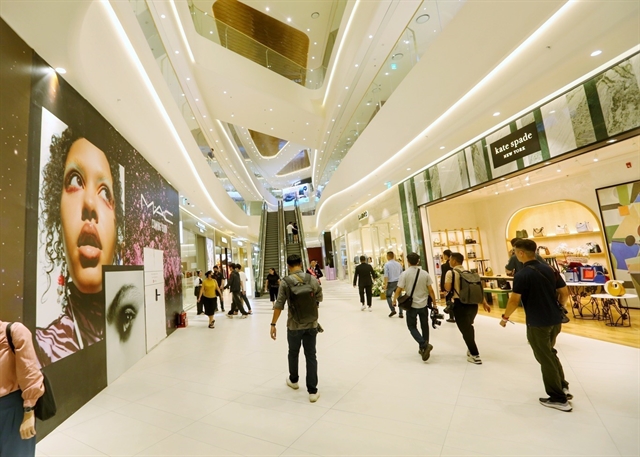This growth in retail sales was largely driven by heightened domestic consumption during the Tết holiday period and a robust recovery in international tourism.

HÀ NỘI — The retail real estate market in Hà Nội experienced steady growth in the first quarter of 2025, driven by new consumer trends, according to CBRE Vietnam’s report released on April 9.
In the first quarter, the retail real estate market saw a modest increase in supply, primarily due to the opening of the AEON Xuân Thủy trading centre, which offers 18,000sq.m of net leasable area (NLA). This addition to the market will contribute to a slight expansion of available retail spaces.
Alongside this, retail sales and consumer services saw a remarkable uptick, with total retail sales in the first quarter reaching over VNĐ1.7 quadrillion – a 9.9 per cent increase compared to the same period in 2024. This growth outpaced the previous year's first-quarter increase of 8.2 per cent, demonstrating a healthy market trend.
This growth in retail sales was largely driven by heightened domestic consumption during the Tết holiday period and a robust recovery in international tourism.
These factors helped reduce the average vacancy rate across the retail market, which fell by 0.8 percentage points compared to the previous quarter, reaching 9.4 per cent.
Looking ahead, the Hà Nội retail market is set to experience an influx of significant new retail supplies in the second and third quarters of 2025 from the two projects of Vincom Megamall Ocean City and Hà Nội Centre.
These new projects are expected to heighten competition within the market but will also provide retailers with more options for spaces that align with their business strategies and scale, said Nguyễn Hoài An, director of CBRE Hà Nội.
In the first quarter, the market recorded a net absorption of 24,760sq.m, a notable increase from the 3,537sq.m absorbed in the fourth quarter of 2024. The demand came primarily from the food and beverage, lifestyle and entertainment sectors, reflecting a shift in consumer habits towards more personalised experiences and services.
Leasing activity in Hà Nội remained dynamic in the first quarter. Asking rents, the rental price listed by the landlord or property manager, in the central business district (CBD) saw a 15.4 per cent year-over-year increase, reaching US$173 per sq.m per month.
The asking rents in the non-CBD areas increased by 5.4 per cent year on year, reaching $37.1 per sq.m per month.
The vacancy rate in the CBD was unchanged with a remarkably low at 1.7 per cent, while in non-CBD areas, it slightly decreased from 10.7 per cent in the fourth quarter of 2024 to 9.8 per cent in the first quarter of 2025, suggesting a positive absorption trend outside the CBD.
In the convenience store segment, competition has been intensifying with the entry of international chains like GS25 with its first six stores in Hà Nội.
The entry of 7-Eleven chain in the near future is expected to further shake up this segment, providing more choices for consumers and increasing competition among convenience store brands.
One of the most significant trends in Hà Nội’s retail market has been the continued expansion of Chinese retail brands, according to CBRE.
Since 2023, several brands – such as Oh!Some, KKV, Semir and Cotti Coffee – have entered the market, and many are planning to expand their presence in both Hà Nội and HCM City.
This influx of foreign brands is diversifying the retail market but also presents challenges for businesses seeking sustainable development for a long period.
An said retailers need to carefully consider local consumer preferences, purchasing power, and the competitive landscape to succeed in this dynamic market.
While the retail market overall shows signs of growth, older shopping malls – despite being in prime locations – are struggling with higher vacancy rates and lower foot traffic.
These shopping centres are increasingly unable to compete with newer, more modern malls that offer a wider variety of services, more attractive designs, and integrated entertainment options.
Examples of such struggling malls in the capital include the Artemis building on Lê Trọng Tấn Street, which has many vacant commercial spaces despite its prime location.
Similarly, the Discovery Complex Mall in Cầu Giấy District and Mipec Tower in Đống Đa District are facing challenges with vacant stores, even though they are situated in well-populated areas.
Experts argue that the shift in consumer behaviour – especially the growing preference for online shopping – has significantly impacted the traditional retail model.
"Shopping malls that have been built recently, have more reasonable designs and meet the needs of consumers and retail brands," An said.
"Spaces are arranged in a way optimising the shopping experience for customers. Additionally, other important factors include the ability of efficient operation, management of tenants, marketing services, and updated new consumer trends.
"All of these core factors contribute to effective operation of the shopping centres for long term.
"Business management in shopping centres is a specialised field that requires investors and managers to possess in-depth knowledge and experience, not only in the retail industry as a whole but also in specific sectors such as food and beverage, fashion, and luxury brands."
Nguyễn Trung Thành, manager of a store at Lotte Mall West Lake, added: "Old shopping malls must change their business model and embrace new trends, if not it will be difficult to attract customers." — BIZHUB/ VNS





